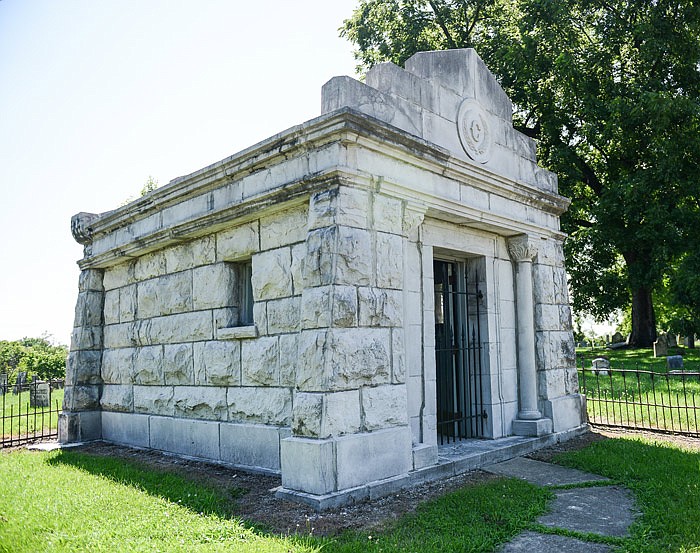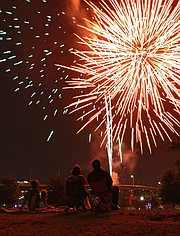Tucked between two appliances at the Clarke Senior Nutrition Center is a lonely bronze figure of city benefactor Maj. Joseph Marcus Clarke.
His family mausoleum at the Old City/Woodland Cemetery was restored by Jefferson City's Cemetery Resource Board this last fiscal year.
On a recent tour of the cemeteries hosted by the board, visitors were told no one was buried in the Carthage limestone structure.
Upon further research, board chairman Nancy Thompson is convinced Clarke and his wife, Lavinia, and possibly their son, Junius, a local lawyer who preceded them in death, are buried in the interior room of the mausoleum.
"Deep are the footprints which he left in this fortunate community which he loved and to which he gave materially during his lifetime and after his death," wrote Margaret Pinet in a 1948 News Tribune.
Maintaining the eye-catching mausoleum fulfills part of Clarke's requirements from his 1889 will.
Creating the bronze likeness and portraits of his wife and two sons, which also hang at the nutrition center, were also part of his will.
In exchange, he donated Bragg Hall, at the northeast corner of Monroe and East High streets, to the city. The city benefited for more than 80 years from the donation, before moving to its present location.
The city sold the building to Robert and Allen Herman in 1981 for $255,000, up from its value of $15,000 at Clarke's death. When the city earmarked the funds for a police and fire department training center, family heirs sought an injunction, reported Richard Orrick in a 1989 Post Tribune.
The Housing Authority requested the funds to build the Joseph M. Clarke Senior Center, dedicated in October 1987 and approved by the family. By 1989, the bronze figure and portraits along with a memorial plaque and excerpts from his will were installed at the center.
Clarke's estate included nearly $150,000 in property from Chicago, downtown Jefferson City and Illinois. Plat books at the Cole County Historical Society showed he had pieces of property across the city, Thompson said.
His will regarding Bragg Hall stipulated $3,000 be raised to form his bronze statue which was to be "kept in a prominent place." And the city also was required to procure life-sized portraits of his wife and children, Marcus and Junius, which were "to be placed in same room."
Clarke's will further said the city must "have oversight and care of my family vault at the city cemetery and keep the same in good repair."
He left half of his fortune to his wife and the other half was divided among other family members, friends and community projects in Illinois, Ohio, Kentucky, Virginia and Mid-Missouri.
And he left $100 each to five named "old family negroes."
He was a founder of the local Christian Church and a major contributor toward the church building and maintaining the pastor's salary.
In addition to being a philanthroper, Clarke was a builder.
His last project was the Merchants Bank building at the southwest corner of Jefferson and West High streets, now owned by Central Bank. He had been a long-time stockholder and president of the First National Bank.
Clarke built a block of homes called Clarke's Row, once along the 200 block of Capitol Avenue. He and Lavinia lived on the northwest corner of Monroe Street and Capitol Avenue.
He was born to an English immigrant and a mother from Virginia in Ohio. His first careers were as teacher, journalist and a traveling horse salesman.
Clarke settled into plantation life in Virginia, where he married his first wife, who died as did several of their children. He also met his second wife, Lavinia Nunnelly, there and with her moved to Kentucky where he entered the merchandise business.
About 1855, the family moved to a farm in Mid-Missouri on the Osage River with their slaves. While there, he represented Osage County twice in the Missouri General Assembly.
He returned to Kentucky at the outbreak of the War Between the States, returning to newspapers for a time.
The Clarkes returned to Missouri, this time to Jefferson City, in 1874 where they lived in "a charming old southern house which stood at Main (Capitol) and Monroe streets," Pinet wrote.
After Clarke died, the commissioned portrait of Lavinia was created by painter Nita Obermueller from Ohio, who lived in the family home for three months while she worked.
Upon finding the Clarke bronze and portraits, Thompson said, "It is a sad end to such a noble, prominent family."


